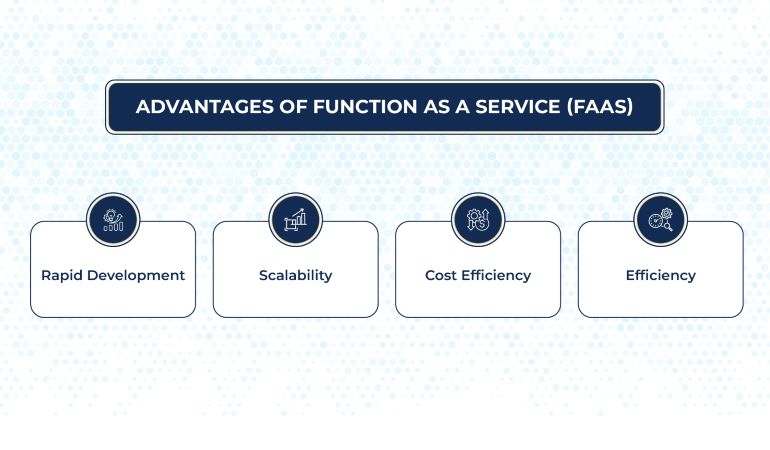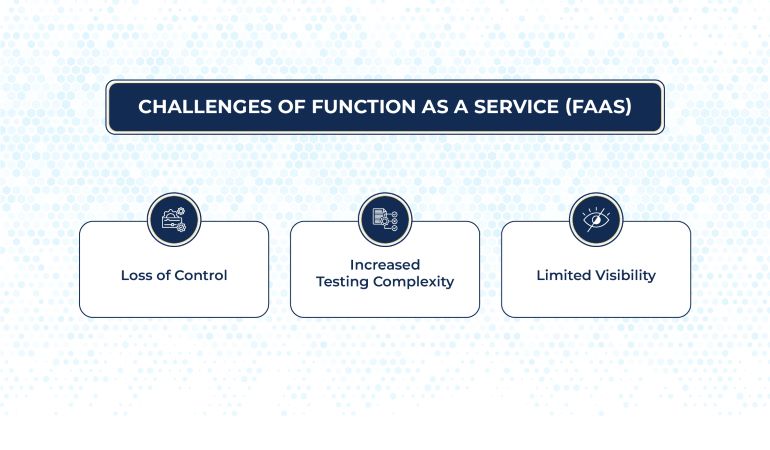Cutting-edge technologies like artificial intelligence, machine learning, and cloud computing are shaping our everyday lives. Technology governs much of what we do today, from shopping (online & offline) to setting up appointments with a doctor. Managed Cloud Services are becoming a trendy way for companies worldwide to run their businesses. And Function-as-a-Service, also known as FaaS, is today’s fastest-growing cloud computing model.
But what is FaaS? How is it linked to serverless and microservices architectures? And why is it growing so rapidly?
Let’s dig deep to uncover the answers to these questions.
Function-as-a-Service (FaaS)
To host an application online, you must provide a physical or virtual server. You must also manage an operating system and web server hosting procedures.
The Function-as-a-Service cloud computing model removes all these requirements. Your cloud service provider handles all this – physical hardware/infrastructure, virtual machine OS, web server management, etc. – to enable your developers to focus on the core product instead.
Here’s what it is.
Function-as-a-Service (FaaS) is a cloud computing model that enables software developers (cloud customers) to build, deploy, run, and manage applications as functions without worrying about the infrastructure. Such infrastructure is usually a vital part of developing and launching applications.
In other words, companies employing the FaaS model run their applications directly from the cloud instead of hosting them on a server. It is time-consuming to run, manage, and maintain servers. Hence, a serverless model like FaaS is quickly gaining traction among businesses.
The best part about FaaS is its event-driven nature, which means that the code executes due to some event that triggers its execution. These events include API requests, scheduled events, events in the database, etc. And you pay for it only when the functionality is executed. These unique features of the Function-as-a-Service model are the reason for its popularity and use.
In the traditional cloud computing model, the code runs on the server continuously, and you are charged for it. Under the conventional model, one must also provision infrastructure, while FaaS removes its need. Therefore, all the other cloud computing models must operate on a server at any given time.
However, with FaaS, the model runs only when a function is executed; it stops after the code is executed.
Examples of FaaS include the following:
- AWS Lambda
- Microsoft Azure Functions
- Google’s Cloud Functions
- OpenFaaS
- IBM Cloud Functions
FaaS and Serverless Architecture: Are they the Same Thing?
Many people use FaaS and serverless interchangeably, but that is a mistake. While there are similarities between the two, there are also apparent differences.
Let’s see what these similarities and differences are.
In the beginning, both terms used to mean the same thing, more or less. However, with time, serverless architecture’s scope expanded to include a set of practices and architectural models that employ the in-depth use of common services, including the custom business logic present in FaaS.
Traditional applications and microservices can use serverless architecture insofar as they abide by state management and scaling requirements while being containerized.
The major similarity between the FaaS and serverless architecture is that both emphasize removing the need for users to manage and configure infrastructure. For example, storage service offered by a cloud service provider means that the service provider handles all the underlying infrastructure, thus removing the need for the users to manage it themselves.
FaaS is an extension and a subcategory of serverless architecture. The latter focuses on any service category, such as database, storage, compute, API gateways, etc. FaaS, instead of serverless, is governed by an event-driven cloud migration strategy where containers or the application code run only in response to some requests (e.g., API requests) or events (e.g., scheduled events).
Hence, the primary difference between the two is that while both eliminate the need for users to configure and manage the underlying infrastructure, serverless runs continuously, and FaaS does not. Function-as-a-Service (FaaS) only runs for a short duration, executes the function, and then shuts down, thus saving you incremental business costs.
This makes Function-as-a-Service one type of serverless architecture, yet the difference between the two remains. It helps to think of serverless architecture as an umbrella term under which FaaS features.
Function-as-a-Service (FaaS) and Microservices
Microservices architecture is an architectural approach employed in software development. It builds software applications as loosely coupled services that communicate through lightweight protocols or APIs. Moreover, microservices architecture helps you develop complex applications using serverless architecture.
You can deploy these loosely coupled services independently. They are testable, highly maintainable, and owned by small, self-contained teams. As an architectural approach, microservices enable your software developers to develop and scale your applications rapidly. It also reduces the time to market, releases new features, and fixes bugs.
Microservices applications are the opposite of yesteryear’s monolithic, tightly coupled applications where all the processes are run as a single service. If you want to meet the surge in demand for one of your app’s processes, you must scale the entire application. Thus, experimentation with new ideas or adding new features to a monolithic application becomes tedious and challenging.
So, how are FaaS and microservices related?
The principle behind the two is the same. In microservices, each service is supposed to do just one thing. It’s the same for FaaS, where each function is supposed to carry out a single operation. Moreover, both FaaS and microservices use virtual containers. FaaS functions are executed in containers, and microservices applications are usually deployed in containers.
Advantages of Function-as-a-Service (FaaS)

- Increased Development Speed: The most significant benefit of Function-as-a-Service is that it enables developers to focus on the application code instead of worrying about managing and configuring the underlying infrastructure. Thus, FaaS expedites your application development process.
- Scalability: Your developers do not need to concern themselves with creating contingencies if your application process experiences a spike in demand. That is because FaaS is, by its very nature, scalable. Your cloud service provider looks after all your scalability requirements.
- Cost efficiency: Another critical advantage of the FaaS cloud computing solutions for business is that your service provider does not charge you for idle computing time. Instead, you are only charged based on the number of functionality executed. Moreover, it saves you a lot of money since you don’t have to manage and configure the underlying infrastructure.
- Efficiency: The FaaS model significantly reduces the application development and deployment periods since costs are less and you can run more workloads.
FaaS Principles and Best Practices
There are various best practices to deploy FaaS and make it more effective quickly:
- Make each function do only one thing: FaaS functions should be designed to do one thing regarding an event. Make your code scope limited, efficient, and lightweight so that the functions load up and run very fast.
- Avoid function calls to other functions: FaaS value lies in isolating functions. Many functions increase your costs and eliminate the value of isolating your functions.
- Minimize libraries used in your functions: Too many can slow down functions and make them harder to scale.
FaaS Use Case
FaaS is suitable for high-volume and parallel workloads because it enables simple isolation and scaling of transactions. Function as a Service can also be used to create backend systems or for data processing, format conversion, encoding, or aggregation.
FaaS is also an excellent tool for web apps, backends, data or stream processing, or for building online chatbots or backends for IoT devices. Function as a Service can significantly benefit you when managing and utilizing third-party services. For instance, if you want to get into Android app development, you can adopt the FaaS approach and keep your costs under control.
Because the charges only occur when your app connects to the cloud for a specific function, such as batch processing, costs can be considerably lower than when using a traditional approach.
Challenges of Function as a Service (FaaS)
On the other hand, FaaS also comes with the following potential challenges to organizations:

Loss of control: Since a third party manages part of the cloud infrastructure, IT teams lose some degree of control over system architecture.
Increased testing complexity: The cloud-based existence of FaaS functions complicates the testing of local applications and makes it more time-consuming.
Limited visibility: With FaaS deployments on and off, visibility is a problem – mainly when the overall number of functions is high.
Conclusion
While FaaS has a few drawbacks, its benefits far outweigh its disadvantages. These drawbacks include increased testing complexity, less system control, and CI/CD pipeline integration issues.
Such issues can be attributed to Function-as-a-Service (FaaS) as a cloud computing model emerged only recently. With time, intelligent developers and innovative tech companies will overcome these issues.
If you need assistance with cloud computing models, Azure DevOps automated deployment, or services, contact us at [email protected].

